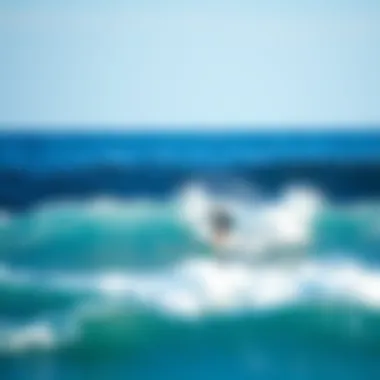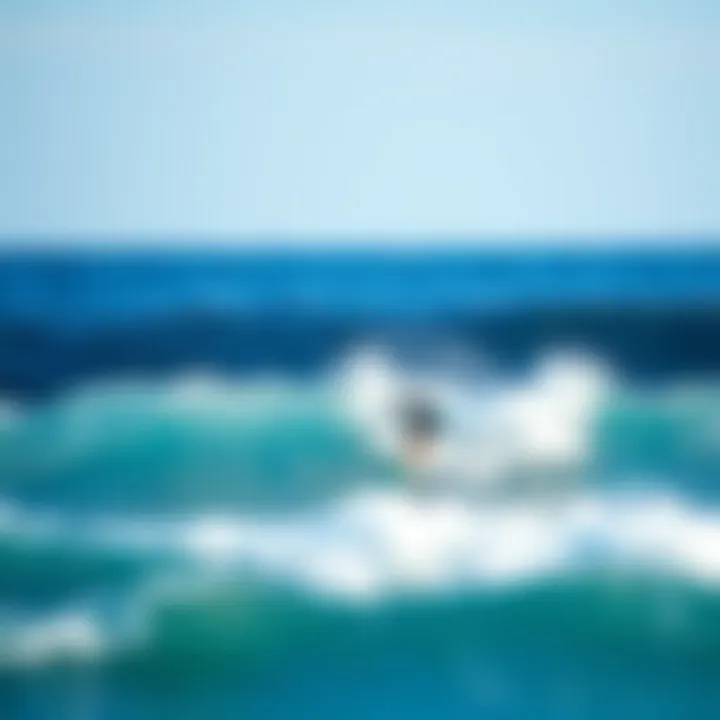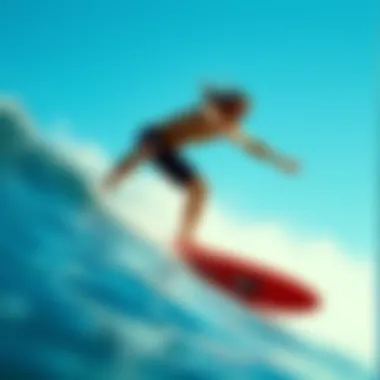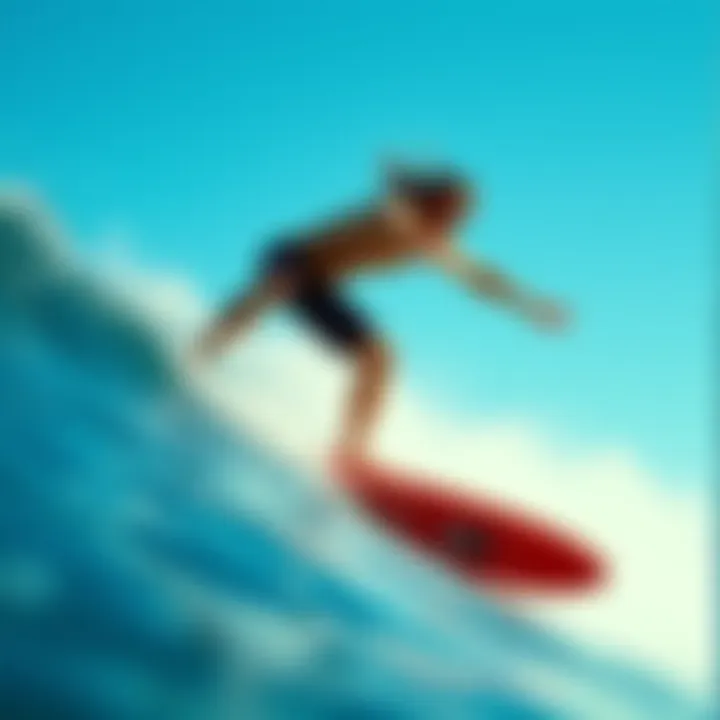Exploring the Diverse Styles of Surfing


Intro
Surfing is more than just a sport; it's a rich tapestry woven from the diverse threads of culture, technique, and technology. While the thrill of riding waves is a common passion among surfers worldwide, the styles they adopt can differ vastly, revealing personal preferences and regional influences. This exploration endeavors to shed light on the various surfing styles that have emerged over the years, each with its unique flair and historical context. By delving into these styles, we aim to enhance the understanding of the sport, inviting enthusiasts and newcomers alike to better appreciate the contemporary and traditional facets of surfing.
In this comprehensive examination, we will discuss essential gear and equipment, ranging from the latest surfboard technologies to must-have accessories for every surfer. Furthermore, we will explore specific techniques and skills that cater to both beginners and those more seasoned in the surf scene. By the end of this journey, readers will not only familiarize themselves with the various surfing approaches but also recognize the significance of each style within the broader surfing community.
As we set the stage, let the waves guide us into the depths of surfing's unique narrative.
Understanding Surfing Styles
Surfing is a vast ocean of experiences, each wave telling a different story depending on the style of riding. Understanding the various surfing styles isn't just about learning the techniques; it speaks volumes about how surfers connect with the water, the wind, and the culture surrounding them. Recognizing these styles offers insights into the evolution of the sport, celebrating the diversity of approaches taken by surfers around the globe.
There’s a certain rhythm inherent in surfing styles, each tailored to different types of boards and techniques that cater to various wave conditions. By diving into the nuances, surfers can make informed choices about their practice, ensuring they align their skills with the right equipment and settings. For someone keen on enhancing their surfing, knowing these styles can be the key to unlocking potential.
Furthermore, understanding surfing styles is crucial for safety reasons. Each style has its own set of challenges and risks, and recognizing these can help novices navigate their way through the learning curve and help seasoned surfers push their limits responsibly.
The Concept of Surfing Styles
At the heart of every surfer's journey lies the idea of style. A surfing style refers to how a surfer interacts with the ocean, which blends their body movements, equipment choices, and personal flair. Different styles cater to varying wave conditions and personal preferences, turning what might be a simple act of riding a wave into an artful expression of individuality.
Take longboarding, for instance. This style, characterized by its elongated boards and smooth turns, often evokes a sense of nostalgia. Longboarders ride in a way that honors the history of surfing, mimicking the slow, graceful curves of waves. The movements often seem choreographed, each turn flowing into the next, creating a visual feast for onlookers.
On the other side, shortboarding is all about agility and precision. It thrives on the fast-paced energy of high-performance surfing, where tricks and rapid maneuvers reign supreme. The shortboarders embody a different essence—their style is electric, a dance on the edge of the wave's power, requiring quick reflexes and impeccable timing.
Ultimately, the concept of surfing styles encapsulates more than just technique; it's a reflection of personal identity, the sea's allure, and the community formed around shared passion. Surfers may gravitate toward specific styles that resonate with them, shaping their experiences in the water.
Cultural Significance of Surfing
Surfing is not merely a sport; it is entwined with cultural narratives that have evolved over decades. Historically, surfing has roots that trace back to ancient Polynesian culture, where it was not only a leisure activity but a profound spiritual practice. Over the years, as it crossed oceans and borders, it adapted and fused with local customs, leading to the diverse microcultures observed worldwide today.
For many, surfing is a lifestyle, characterized by camaraderie, respect for nature, and a communal spirit. Surf culture has bred its own lexicon, fashion, and rituals, visible through surf films, art, and global contests like the World Surf League.
Importantly, the cultural significance of surfing extends into environmental stewardship. Surfers often become passionate advocates for ocean conservation—a response to witnessing the impact of climate change and pollution on their beloved waves. The close connection surfers have with the ocean fuels a sense of responsibility to protect marine ecosystems, making them pivotal in conservation efforts.
"Surfing is like life. It’s about finding balance, riding the highs and lows, and respecting what comes your way."
Exploring surfing styles deeply enriches one’s appreciation for the sport, and encourages surfers to embody the principles of respect, growth, and connection inherent in their craft.
Traditional Surfing Techniques
Traditional surfing techniques remain the bedrock of the sport, demonstrating not only the heritage of surfing but also the nuanced skills it demands. Understanding these techniques opens doors to mastering the waves and appreciating the culture surrounding them. Essentially, traditional techniques encompass styles that have been refined over decades, each with unique expressions and nuances. Familiarity with these methods is crucial for anyone wanting to evolve in their journey as a surfer.
Longboarding
History and Origin
Longboarding finds its roots in the early days of surfing, often traced back to the ancient Polynesians. Back then, the boards were made from heavy woods, and riders often surfed standing up to challenge the waves. The resurgence of longboarding in the 1960s brought about a renewed fascination with this style. The narrative of longboarding showcases its primacy in the surfing culture because it embraces a smooth, graceful ride characterized by flowing maneuvers.
Because of its history, longboarding is seen as a beanpot of style and technique, offering a beneficial choice for both nostalgic surfers and newcomers alike.
Essential Techniques
To really get the hang of longboarding, surfers should learn essential techniques. Foot placement, buoyancy, and balance form the crucial trifecta of skill needed here. Longboarding demands a deeper connection with the board and the wave, which encourages both precision and rhythm. People often appreciate longboarding for the space it grants to express creativity on the water.
One unique feature of longboarding is the nose ride, allowing surfers to walk to the front of their board, giving them an exhilarating experience. While this offers a beautiful aesthetic on the waves, it does also expose surfers to potential falls if they misjudge their balance.
Board Characteristics
The characteristics of longboards contribute significantly to their performance. Typically, these boards range from 8 to 12 feet in length and are wider than shortboards, enhancing stability and ease of paddling. This characteristic makes them an attractive choice for beginners who often find paddling easier and more forgiving than with shorter counterparts.
The concave and rocker designs on longboards greatly affect performance in various surf conditions. While their size benefits stability, it can also present a disadvantage in certain wave conditions—especially in choppy waters—where shorter boards might excel.
Shortboarding
Different Types of Shortboards
Shortboarding is all about speed and agility. With a managed length typically between 5 to 7 feet, shortboards are designed for performance, allowing surfers to execute a higher degree of tricks and turns. A range of shortboards, like thrusters, quads, and fish, cater to different levels of expertise and wave conditions. Each type carries its unique characteristics: for instance, the thruster is famed for its versatility, making it a common pick among competitive surfers.
This variety enhances the appeal of shortboarding in this article, as it illustrates how shaping allows for personalized surfing experiences.
Performance and Tricks


The thrill of shortboarding lies in its performance capabilities. The locked-in foot placement and responsive design allow for rapid turns and maneuvers, enabling surfers to engage in aggressive tricks like airs and spin-offs. These techniques make shortboarding a playground for performance enthusiasts who revel in challenging themselves on bigger waves. The adrenaline rush involved in pulling off these complicated stunts adds a unique layer to the surfing experience, marking it as a choice that continuously evolves.
Wave Conditions
Shortboarding thrives in a specific range of wave conditions, generally favoring steeper waves with considerable power. Understanding wave dynamics becomes essential for shortboarders; choosing the right surf can mean the difference between a thrilling ride and an uncomfortable wipeout. Moreover, adapting to varying conditions helps surfers build resilience and improve their overall skills, making wave condition awareness indispensable for anyone engaged in the sport.
In essence, traditional surfing techniques, particularly those of longboarding and shortboarding, highlight the rich history and technical mastery required in surfing. By exploring these styles, surfers can deepen their understanding of the sport itself and its vibrant culture.
Emerging Surfing Styles
With the world of surfing constantly evolving, emerging styles represent not just new techniques but also shifts in culture and community engagement. These innovative approaches bring diverse perspectives to the sport, encouraging both seasoned surfers and newcomers to explore the ocean in ways they might not have considered before. Understanding these styles can deepen one’s appreciation for surfing as a multifaceted activity.
Stand Up Paddleboarding
Stand Up Paddleboarding, or SUP, has skyrocketed in popularity over recent years. This form of surfing promotes a unique way of interacting with the water while maintaining a connection to traditional surfing. Here's a closer look at what makes SUP a significant part of the current surfing landscape.
Techniques and Equipment
When venturing into Stand Up Paddleboarding, the right techniques and equipment make all the difference. An essential aspect of SUP is learning how to balance on the board while using the paddle effectively. This combination enables surfers to navigate both calm waters and waves with ease. SUP boards are longer and wider than traditional surfboards, often made from materials like epoxy or inflatable technologies. The buoyancy of these boards reduces the strain on the paddler, making it a popular option for those who want to experience the ocean without the intense commitment required for traditional surfing.
Benefits and Drawbacks
Stand Up Paddleboarding offers a multitude of benefits, but it comes with its own set of challenges too. On the plus side, SUP provides a full-body workout. Engaging core muscles is a given, but the paddling motion builds arm and shoulder strength as well. Additionally, SUP is accessible to a broader audience; people of various ages and skill levels can enjoy it. On the flip side, if conditions become choppy, beginners might find SUP a bit tricky. Managing a longer board amidst rough waves can be daunting, and the learning curve might discourage some.
Suitable Wave Conditions
The beauty of Stand Up Paddleboarding is its versatility concerning wave conditions. Unlike traditional surfing, which requires specific types of waves for quality riding experiences, SUP can be enjoyed in flat waters, as well as small to medium-sized waves. This ability allows paddleboarders to explore various environments, such as lakes, rivers, and coastal areas. However, larger and more powerful waves can present safety risks, requiring paddlers to be cautious and aware of their limits.
Kitesurfing
Kitesurfing combines elements of traditional surfing with the thrill of kite flying, making it an exhilarating choice among adrenaline junkies. Understanding the essentials of this sport can introduce surfers to a whole new dimension of wave riding.
Equipment Overview
The equipment used in kitesurfing consists of a kite, a harness, and a board, usually referred to as a twintip or directional board. The kite is tethered to the rider via lines attached to a control bar. The key to effective kitesurfing is mastering the balance between the wind's power and the rider's positioning. This balance is crucial, as improper handling of the kite could lead to falls or accidents. With its unique setup, kitesurfing is attractive to those seeking a dynamic water sport experience.
Techniques for Beginners
For newcomers, kitesurfing techniques are essential to grasp before hitting the waves. Starting with land training is common, allowing novice riders to familiarize themselves with kite control without the added complexity of water. Once comfortable, riders typically progress to smaller waves and lighter winds to safely learn the ropes. Getting the hang of steering the kite while balancing on the board might be challenging initially, but the rewards of successful rides can be immensely gratifying.
Safety Considerations
Kitesurfing comes with inherent risks that need to be acknowledged and managed effectively. Understanding wind conditions is crucial; failure to do so can lead to mishaps or accidents. Riders must also familiarize themselves with local regulations and safety guidelines. Proper gear, such as a helmet and impact vest, is not just recommended; it’s vital. Furthermore, kitesurfers should always ride with a buddy when possible, ensuring that help is at hand should a problem occur.
Alternative Surfing Formats
Alternative surfing formats offer unique experiences and challenges, catering to a variety of styles and preferences among surfers. These formats work as a bridge between traditional surfing and modern adaptations, providing broader accessibility and inclusivity within the sport. Whether you’re riding waves on a small board or using specialized equipment, understanding these alternative formats enhances one’s surfing repertoire.
Bodyboarding
Bodyboard Characteristics
Bodyboarding stands apart for its compact design and ease of entry, making it particularly appealing to newcomers and seasoned surfers alike. The typical bodyboard is smaller than a traditional surfboard and made from durable foam, contributing to its lightweight nature. This characteristic plays a key role in allowing riders to quickly dodge toward incoming waves effortlessly.
One notable feature of bodyboards is their crescent tail, which enhances maneuverability in the water. This enables bodyboarders to easily make sharp turns and execute tricks with more flair. The benefits of these characteristics are visible in crowded surf spots, where bodyboarding can thrive on smaller waves, allowing enthusiasts to enjoy the ocean even on less-than-ideal days.
Basic Techniques
When it comes to basic techniques in bodyboarding, mastering the prone position is foundational. Unlike traditional surfing, where a stand-up approach dominates, bodyboarding allows surfers to lie on their stomachs, giving them a lower center of gravity and improved stability on various wave conditions.
This technique fosters a unique connection with the ocean, as riders can feel the power of the waves beneath them. Additionally, bodyboarding is often described as less strenuous, making it a favorable choice for those seeking more leisurely sessions without complex balancing skills required for traditional surfboards. However, the downside lies in its limitations; as riders gain experience, many might seek the thrill of standing upright on a board over time.
Popular Destinations
When considering popular bodyboarding destinations, places like Pipeline in Hawaii and Teahupo'o in Tahiti are among the most celebrated. These spots provide excellent conditions and formidable waves, ideal for experienced riders who wish to showcase their skills.
The unique feature of these locations is the diverse range of wave forms available, catering to different skill levels. From mellow beach breaks suitable for beginners to heavy reef breaks that challenge the most experienced, bodyboarding destinations provide varied experience while embracing the thrill of the ride. However, safety should always be paramount, as waves at these locations can be dangerous and require a solid understanding of local conditions.
Tow-in Surfing
Equipment Used
Tow-in surfing requires a distinct set of gear that differs markedly from traditional surfboards. Typically, this method utilizes a jet ski or a personal watercraft which gives surfers the ability to paddle into larger waves that would be impossible to catch alone.


The surfboards used in tow-in surfing often feature a smaller design and a specialized fin setup designed for high-speed maneuvers. A notable quality about this equipment is its ability to remain stable even in the most challenging wave scenarios. This reliability allows surfers to concentrate on their performance, rather than worrying about their board. However, without proper understanding and respect for the equipment, the sport can become dangerous quickly.
Technique Description
The technique behind tow-in surfing revolves around synchronization between the surfer and the driver of the jet ski. A well-timed rope drop is essential to optimize the ride onto the wave. Once the surfer is on a wave, they must maintain acceleration to perform tricks or stay atop the wave face.
A key characteristic of this technique is the ability to ride waves significantly bigger than what paddling could allow, unlocking a new dimension of surfing. However, this advantage comes with complexities; riders need to adapt to different maneuvers and maintain communication with the jet ski operator constantly, necessitating teamwork.
Risks Involved
Tow-in surfing, while exhilarating, is not without its risks. The speed involved means that wipeouts can lead to severe injuries if not executed with care and precision. Surfers must remain vigilant regarding marine conditions and potential hazards in the water.
Additionally, the reliance on mechanical equipment like jet skis introduces another layer of risks, such as mechanical failure or collision. Surfers and drivers must ensure they operate in tandem, factoring in both skill and safety. While this sport offers a thrilling experience, heavy emphasis on safety protocols is necessary for enjoying these large waves responsibly.
"The thrill of riding massive waves is unmatched, but understanding the risks involved ensures that the sport remains safe for everyone."
By diving into various alternative surfing formats, surfers can not only expand their skills but also enjoy the versatility that comes with different styles. Whether choosing to ride the waves on a bodyboard or harnessing the power of tow-in surfing, understanding the characteristics, techniques, and risks associated expands the overall surfing experience.
Technical Aspects of Surfing Styles
Understanding the technical dimensions of surfing styles offers a window into not just the sport but the evolving relationship surfers have with the ocean. These aspects ensure that every wave rider can find their niche, adapting to the ever-changing sea conditions while using the right techniques and equipment to enhance their experience.
Wave Selection
Choosing the right wave is paramount for surfers, as it directly influences their performance and enjoyment. Understanding how waves form and behave leads surfers to make more informed choices about where and when to ride.
Understanding Swell Patterns
Swell patterns are the underlying factors that determine wave activity in any given location. Knowledge of these patterns can spell the difference between a lackluster session and an epic ride. By paying attention to wind direction, water depth, and the seabed's topology, surfers can gauge when waves are likely to build and break.
Key Characteristics:
Swell patterns often correlate with specific regions known for consistent wave action—such as the North Shore of Oahu during winter months. This predictive nature is immensely beneficial, empowering surfers to optimize their time on the water.
Unique Features:
For instance, understanding that longer swells are typically smoother than short waves helps in selecting the best conditions for various surfing styles. However, one must also consider the risk of crowding at popular spots, which can lead to competition and potentially dangerous situations.
Identifying Suitable Waves
Once a surfer understands swell patterns, the next step is identifying waves fit for their style. Different techniques apply depending on the type and size of the wave, affecting a surfer's performance greatly.
Key Characteristics:
The ability to discern whether a wave is peaky or mellow can heavily influence how well a surfer executes their maneuvers. For instance, a shortboarder might thrive on a steep, punchy wave, while a longboarder may prefer a softer, rolling break.
Unique Features:
Identifying suitable waves also involves understanding the ocean's mood—how tides and swells interact, impacting wave height. Yet, there’s a conundrum; sometimes ideal waves come with unpredictable rip currents, adding to the challenge and excitement.
Impact on Different Styles
The effects of wave dynamics are significant as they shape techniques adopted across various surfing styles. Each style requires unique responses to waves, which ultimately defines the character of surfing.
Key Characteristics:
For instance, shortboarding often embraces high-flying tricks and quick turns, suited to aggressive waves that provide momentum. Longboarding, on the other hand, thrives in smoother, more consistent waves that allow for extended rides and style-focused maneuvers.
Unique Features:
This division in approach underscores how pivotal wave analysis is to not just performance but also to the surfer's self-expression. However, climatic shifts and fluctuating ocean patterns are precisely why surfers need to stay adaptable across styles.
Board Technology Evolution
The development of surfboards over the years reflects the ongoing quest for performance enhancement. An understanding of the materials and designs influences a surfer's potential on the waves.
Materials Used
Materials are the backbone of surfboard production, significantly affecting weight, durability, and overall performance. The evolution from traditional wood boards to today’s high-tech materials tells a tale of innovation.
Key Characteristics:
Common materials like polyurethane foam for cores and fiberglass for the exterior have become standards, allowing boards to be both lightweight and resilient. This shift towards performance materials caters to the demands of modern surfers who seek agility and speed.
Unique Features:
Yet, while lightweight boards enhance speed, they might sacrifice durability, leading to issues like dings or cracks that require repairs. The balance between weight and sturdiness remains a topic of discussion among surfers.
Design Innovations
Surfboard design has also seen remarkable transformations, enhancing usability. Different shapes cater to various styles, providing more customized riding experiences.
Key Characteristics:
The introduction of rocker and width variations adjusts how a surfboard interacts with the water, allowing what works for one style to nonchalantly fall flat for another. This innovation expands opportunities for surfers to explore diverse conditions effectively.
Unique Features:
Yet, innovations can lead to confusion as novices may struggle to choose the right board design for their needs. The broad array of options could lead to indecisiveness, especially for those just starting.
Performance Enhancements
Performance enhancements have culminated from the fusion of materials and design. Surfers now seek boards that resonate with their riding style while maximizing their ability to maneuver.


Key Characteristics:
Technological advances like aerial fins enhance stability and control, further enriching the surfer's skill set. Modern boards often incorporate technologies that improve buoyancy and speed, essential for executing complex tricks.
Unique Features:
Nonetheless, higher levels of performance often come with a price tag, making it a balancing act of cost versus benefits for many surfers. The choice of investing in performance gear may depend on the individual's commitment and proficiency levels.
The Technical Aspects of Surfing Styles delineate not just the technical skill but also the equipment that serves as an extension of the surfer. Understanding these aspects can pave the way for a deeper appreciation of the sport and its varied forms.
The Lifestyle Surrounding Surfing Styles
Diving into the lifestyle around surfing styles reveals a world that's as rich and intricate as the waves themselves. It's more than just a sport; it’s a culture infused with community, identity, and a strong sense of place. The way people engage with this lifestyle varies widely based on surfing style, region, and personal values, reflecting not only the physical act of riding waves but also the broader social and environmental influences.
Surf Culture
Surf culture embodies a unique confluence of attitudes, habits, and shared values among surfers. It's a subculture that doesn’t just exist along the coastlines but permeates various aspects of life for many enthusiasts.
Community Aspects
Key Characteristics: At its core, surfing is about community. When surfers gather, whether at local spots or international competitions, they share more than just the ocean; they share stories and experiences. This camaraderie fosters a sense of belonging that is crucial. Surfing transcends simple participation; it cultivates deep friendships, mentorship, and collective respect. Surfers often act like a family, helping each other in and out of the water.
Unique Features: Surfers usually develop strong local ties, which bolsters community spirit. However, there's a flip side — the exclusivity some surfers can exhibit toward newcomers. While this can sometimes create competition, it also reinforces loyalty among those who have earned their place in the lineup. Communities often organize events, beach clean-ups, or surf camps, promoting both unity and environmental responsibility.
Impact on Travel and Exploration
Key Characteristics: Surfing is known for igniting wanderlust. Many surfers plan their travels around surf spots, from Bali's famous breaks to the lesser-known gems of El Salvador. The quest for waves drives a significant portion of travel among enthusiasts, leading to adventurous exploration and cultural exchange.
Unique Features: This adventurous spirit often translates to shared experiences that extend beyond the ocean. For instance, surfers frequently make new friends wherever they go, transcending language barriers and cultural differences. However, this constant jet-setting can lead to environmental concerns, like overcrowding in popular surfing locations. Balancing the thrill of discovery with sustainable travel practices is an ongoing challenge for the surfing community.
Fashion and Identity
Key Characteristics: Surfing culture has developed its own fashion sense, heavily influenced by the lifestyle it promotes. Brands like Quiksilver and Billabong don't merely sell clothing; they sell an identity, one that embodies freedom and a love for the ocean.
Unique Features: Many surfers wear specific styles to express their individuality, whether it’s vintage board shorts, eco-friendly wetsuits, or custom-made boards. This identity holds power — it shapes how they relate to each other and to the world. However, the pressure to conform to certain aesthetic norms can sometimes overshadow the true ethos of surfing.
Environmental Considerations
The conversation around surfing lifestyles increasingly intertwines with environmental considerations. Surfing, rooted deeply in nature, faces the reality of climate change and its impacts on oceans and beaches.
Sustainability in Surfing
Key Characteristics: As surfers spend significant time in nature, there’s a growing understanding of their role in its preservation. Many surfers advocate for sustainability, focusing on using eco-friendly gear and supporting clean ocean initiatives. Environmental stewardship has thus become a significant aspect of modern surf culture.
Unique Features: The annual World Surfing League has begun prioritizing sustainability, which is seen in events promoting ocean conservation. The benefits are twofold: while it helps to protect the environment, it also cultivates a positive image for the sport. Yet, the challenge remains — how to balance thrill-seeking with a sincere commitment to the planet.
Conservation Efforts
Key Characteristics: Conservation isn't just a buzzword in surf culture; it’s a rallying cry. Organizations like Surfers Against Sewage actively address pollution, advocating for cleaner beaches and healthier oceans.
Unique Features: The dedication to conservation efforts often resonates deeply within the surfing community. When surfers band together to protect their playground, they not only ensure a sustainable future for the sport but also strengthen community ties. However, challenges remain, particularly when local governments don’t prioritize such efforts.
Impact of Climate Change on Surfing Locations
Key Characteristics: The effects of climate change can no longer be ignored. Rising sea levels, increased storm intensity, and changing swell patterns pose threats to beloved surf spots globally.
Unique Features: These changes force surfers to adapt, often seeking new locations or innovative methods of surfing. The realization of climate-induced impacts encourages surfers to engage with broader environmental conversations, contributing to a heightened awareness of global ecological issues. Yet, not every surfer feels compelled to act, leaving a gap in community-driven action.
Surfing is not just about riding waves. It's a lifestyle, a community, and a responsibility that connects us all to the ocean.
In summary, the lifestyle surrounding surfing styles is incredibly multifaceted – from the strong communities and identities fostered through shared passions to the pressing environmental duties facing surfers today. Understanding this lifestyle enriches the overall appreciation of surfing, deepening the connection surfers have with their sport and the world.
Epilogue
In the realm of surfing, the journey is as important as the ride itself. As we delve into the future of surfing styles, it becomes evident that innovation and tradition will continue to coexist, shaping the experiences of surfers around the globe. The evolution of surfing is not merely a reflection of new techniques or equipment; it is a testament to the sport's ability to adapt to changing social values, environmental factors, and technological advancements.
The Future of Surfing Styles
Looking ahead, a few trends and considerations stand tall. First, the integration of sustainable practices within surfing culture is becoming crucial. As environmental awareness grows, surfers are increasingly opting for eco-friendly boards and participating in conservation initiatives. This shift not only helps preserve the natural beauty that surfers cherish but also encourages a sense of responsibility within the community. Surfers are recognizing that maintaining clean beaches and healthy oceans is fundamental to their sport's future.
Next, technology in surfing gear is advancing at a rapid clip. New materials and designs are enhancing performance while making equipment more accessible. For instance, boards are becoming lighter and more durable. Wearable tech, like surf watches that track wave counts, surf times, and even offer coaching tips, is appealing to a wide range of surfers—from beginners to seasoned pros.
Furthermore, the incorporation of surfing into mainstream media and competitive formats is reshaping perceptions. The rise of social media platforms has created a new wave of influencers, spreading awareness and excitement about surfing styles previously lost in the shuffle. Events like Surfing's inclusion in the Olympics marks a significant moment, drawing attention to an array of styles that extend beyond competitive norms.
"The future of surfing styles lies at the intersection of tradition and innovation, with sustainability at its core."
Moreover, as urban populations swell, we might witness a burgeoning interest in alternative surfing environments. Wave pools and artificial surfing setups are providing opportunities for new surfers to experience the sport in controlled settings. While purists may scoff, these innovations serve to democratize surfing, making it accessible to varied populations who may not have been able to enjoy the ocean's waves.
In summary, the examination of surfing styles is not a static endeavor. It reflects a dynamic tapestry woven from various influences, each adding depth to the community. As we embrace the uncharted waters ahead, surfers must remain adaptable, recognizing the importance of innovation while staying true to the roots that make surfing not just a sport, but a lifestyle. Readers are encouraged to look forward to both the evolution of their skills and the diversity of experiences surf culture has to offer.
For further exploration, interested individuals might delve into resources such as Wikipedia on Surfing, or witness discussions on forums like Reddit, where passionate surfers share knowledge and experience.
Engaging with these changing tides will not only enrich the personal journey of each surfer but also ensure the vitality of the community, keeping the spirit of riding waves alive for generations to come.







